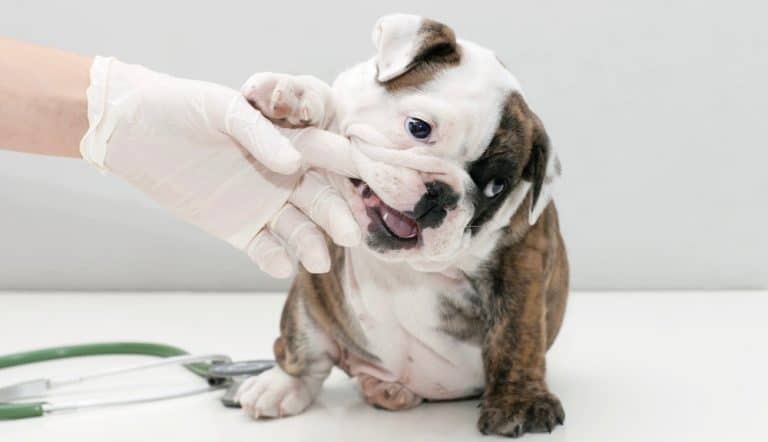Dog Ear Wax Color Chart – What To Watch For
It is perfectly normal for your dog to have ear wax in his ear canal. Ear wax is also referred to as cerumen and is created by specific glands inside your dog’s ear. A dog ear wax color chart can assist in providing information about your dog’s health.
What Is Ear Wax?
Ear wax protects the inner ear by collecting dirt, pollen, debris, bacteria, and dead cells.
When these foreign substances have been collected, the wax oozes out of the ear naturally, so the ear canal is cleaned.
Even though ear wax is normal within humans and your dog, you should understand and take notice of any changes in smell, color, and amount of ear wax so that you can be aware of potential health problems that may exist within your dog.
Understand that the ear organ has three parts: the inner, middle, and outer ear canal. The outer ear or external ear canal will be visible to you and comprises cartilage skin and fur.
This is also called the pinna, and most diseases that affect your dog start from the pinna. Expect that the inner part of the pinna will be pink in a healthy dog.
Is It Normal For A Dog To Have Ear wax?
Yes. It is normal for your dog to have ear wax. In fact, healthy ear wax has many functions that include:
- Keeping the ear canals clean
- Trapping irritants, including dirt and debris
- Moisturizing and lubricating for the ear canal
- Preventing infections
Are Certain Dog Breeds More Prone To Ear Wax Problems?
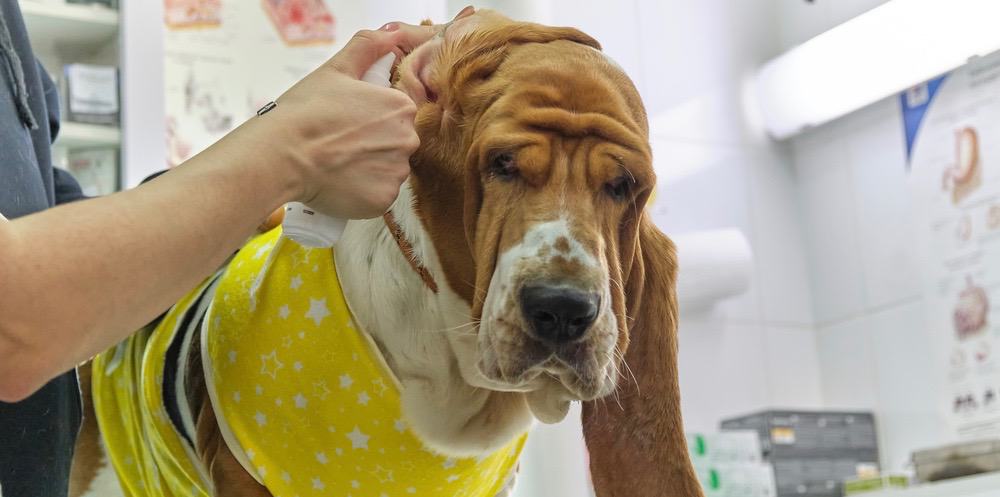
There are some dog breeds with a bit more ear wax than others. These are breeds like Cocker Spaniels, Basset hounds, Poodles, and English Bulldogs.
This is because of the shape of their ears and the fact that the ear canal may have hair growing out of it. Additionally, they may simply have a genetic condition resulting in an overproduction of ear wax.
There are other reasons why a dog may have more ear wax. For example, if you frequently take your dog to the beach or pool, he may have extra ear wax.
The moisture in the ear creates an environment where bacteria can thrive, which may lead to disease.
To prevent diseases affecting the ear, it may be a good idea to place cotton balls in your dog’s ear whenever you expect him to get wet, like swimming or bathing.
Additionally, you should ensure that when he receives a haircut, the hair that is being cut doesn’t enter the ear canal and cause infections.
Dog Ear Wax Color Chart


Yellow/Pale Ear Wax
If you notice that your dog has yellow or pale ear wax, this could mean that things are normal where ear wax is concerned, but in certain cases, he may have an ear infection which may lead to the overproduction of ear wax, mites, polyps, and allergies.
Your dog can get this when he has too much moisture in his ears, creating an environment for infection.
Red Ear Wax

If you notice that your dog has red ear wax, then this is certainly not a good sign. This usually means that there is some type of blood mixed within the ear wax.
This may be because your dog constantly scratches his ears or there may be an injury within his ear canal because of insect bites or other damage.
The worst-case scenario is when his eardrum is ruptured. This causes bleeding that then mixes with the wax.
Brown Ear Wax
This is in the normal range. When you have an adult dog, you should expect that the ear wax will be different in texture than when your dog is a puppy. Usually, older dogs have a harder texture of ear wax, which is usually light brown, orange, or yellow in a healthy dog. The normal range is usually yellow to light brown.
Dark Brown Ear Wax
If you notice dark brown ear wax in clusters or it resembles coffee grounds, it could indicate a possible ear mite infestation. Dark brown and black ear wax is also often associated with a bacterial infection or yeast infection.
When you notice dark brown ear wax, you want to consult your veterinarian because there is most likely an ear problem that needs to be treated.
Reddish Brown Ear Wax
Ear mites are contagious parasites that spread easily from one dog to another. When ear mites are present, they can cause pain and inflammation.
Dark red, brown, or black ear wax is a good indicator of ear mite presence. This is another instance you may want to consult with your veterinarian.
In addition to ear mites, reddish brown ear wax can also result from an allergic reaction, polyps, an overproduction of ear wax, or excessive bathing or swimming.
Light Brown Ear Wax
When a dog has light brown ear wax, it is expected and considered normal. However, if this ear wax comes with any kind of odor or inflammation, then there could be an infection, and you will need a veterinary consultation to determine the care your dog needs.
It is also important to remember that small amounts of fungi and bacteria in the dogs ears are normal. When the wax buildup accumulates, it may lead to overgrowth and inflammation.
Green Ear Wax
If you notice any yellow or pale green ear discharge and not just wax, then there might be mucus caused by inflammation. It is often caused by the bacteria P. aeruginous and occurs in the middle or external ear canal.
This can be hard to treat as it is usually drug-resistant. If the ear discharge begins oozing and has a strong odor, there could be a severe infection that requires immediate treatment.
Gray Ear Wax
If your dog has gray ear wax, this is not a good sign. Gray ear wax usually means the ear is inflamed, causing the ear canal environment to change. With this change in environment, yeast production affects the color of the ear wax. These yeast organisms are normal in the ear canal and skin.
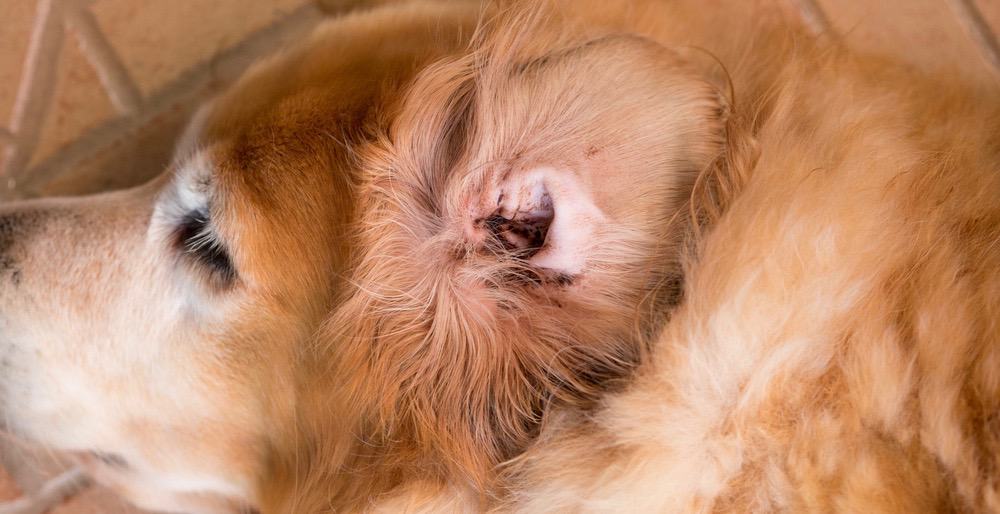
Black/Dark Brown Ear Wax
If your dog’s ear wax is dark brown, it is usually a sign that this ear wax is older and did not slide out of the ear like it was supposed to.
There is usually dirt and bacteria trapped inside it. If your dog has black or dark brown ear wax and frequently scratches his ears or shakes his head, you should schedule a visit with your veterinarian for the best treatment.
Dog Ear Wax Problem Symptoms & Causes
Usually, when your dog has a problem with ear wax, it is caused by an infection in the outer ear canal.
Yeast, bacteria, ear mites, or an infected injury may bring on these infections. An infection may also be caused by polyps or allergies that affect the ear.
You may notice a strange odor on your dog, or he may have inflamed skin. Additionally, you will see him shaking his head in this comfort or scratching his ears and whining.
You can also tell by the amount of ear discharge produced in the ear because ear wax tends to be overproduced when the ear is infected.
If the ear infection is not treated promptly, there could be serious consequences for your dog, as he may lose balance when the infection spreads to the middle ear. Or it may even result in loss of hearing as well as strange eye movement.
The yeast and bacteria that affect the ear change your dog’s odor, so that is something that you should look out for.
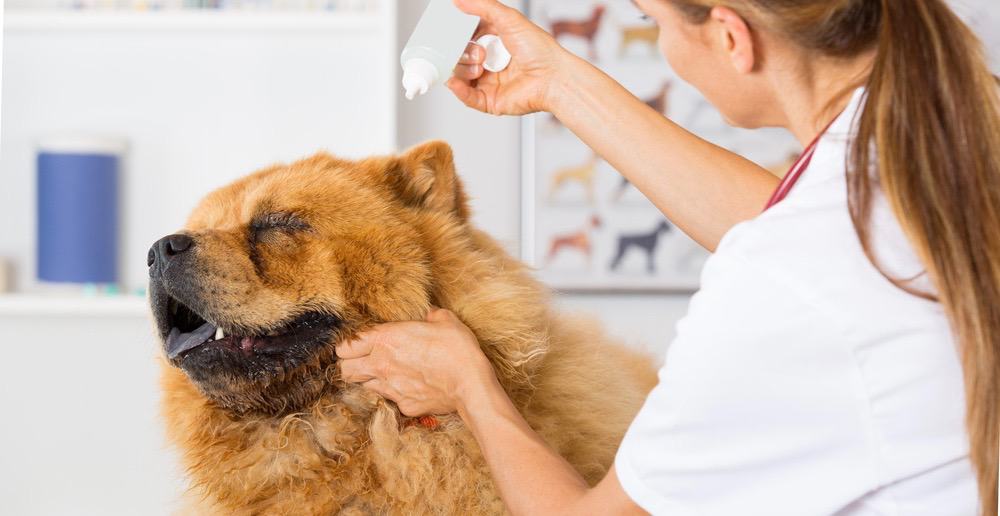
The yeast and bacteria that will affect your dog’s ears are external causes that have come about from grooming or injury. But these are not the only ways to cause infections in your dog’s ear.
Certain conditions within the old dog can lead to problems that affect his ear. These problems should be addressed by visiting your veterinarian to secure your dog’s health.
Providing your dog with a healthy diet is also important for better overall health.
These conditions include:
- Keratinization disorders (seborrhea, overproduction of cerumen)
- Idiopathic
- Autoimmune diseases (pemphigus complex, lupus erythematous)
- Non-neoplastic polyps
- Tumors (malignant or benign)
- Foreign bodies(plants, hair, seeds)
- Hypersensitivity (FAD, food-borne allergies, atopic allergies)
- Endocrine disorders (hormone imbalances, hypothyroidism, Cushing)
- Hay Fever and Allergies: Allergies are a very common cause of excessive ear wax for a dog. Wax production in the ears increases as the skin barrier breaks down during an allergic reaction. Bacteria love these conditions, which can greatly increase the risk of inflammation and irritation.
- Ear Mites: These are contagious parasites that can easily spread from one dog to another. Ear mites can cause severe inflammation and pain and often come with darker shades of ear wax. Call the vet if you notice dark red, brown, or black ear wax.
- Infections: You may find that your dog is more prone to ear infections than the next. So, you want to identify which ear wax color is normal and what you need to watch for and discuss with your veterinarian.
When it comes to ear infections, about half the cases are caused by allergies that your dogs have.
Apart from that, there has to be some type of foreign body causing the infection. If you are careful whenever you groom your dog, you can reduce most of the problems. Also, aim for a healthy dog overall so these issues can be minimized.
Preventing Ear Problems In Dogs
As we have stated, the accumulation of ear wax in your dog is quite normal, but there are cases where certain conditions within the body may be the cause, as well as activities your dog is engaged in that may lead to infection in the ear canal.
When your dog constantly scratches his ears, he may have certain allergies, and if this condition is left untreated, it may cause him to have inflammation and infection.
The best thing you can do is visit your veterinarian, who would be able to help you by recommending the proper treatment for your dog.
In most cases, it may be just a matter of prescribing a certain medication, but on occasion, it may call for more drastic measures that require support and dedication as the dog owner.
Instead of waiting for your dog to develop these problems with his ear, you should be proactive and take preventative measures, such as ensuring his ears are clean and correctly cleaning them and ensuring that his ear canal does not create an environment where yeast and bacteria will thrive.
You also need to take care of his health so that certain health conditions well knobs create an environment where his ear canal can get infected. You need to also look for any indication that your dog’s ears are infected by observing him to see if he is scratching and is uncomfortable.
How To Clean Your Dog’s Ears (Ear Wax Removal)
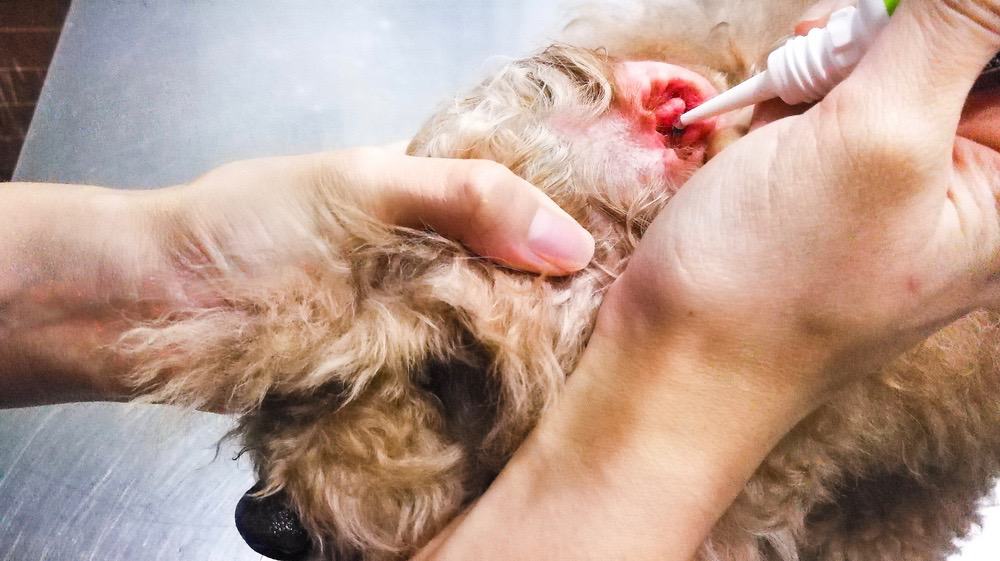
You shouldn’t wait until your dog has an ear infection to do the right thing and clean his ears. Cleaning his ears should be a part of regular grooming, although some dog breeds would need this more than others.
If you are unsure about what to do and do not want to take the chance, having your groomer or your veterinarian handle it is perfectly okay. It is better to do this than potentially injure your dog.
However, it is not that difficult if you want to learn how to clean your dog’s ear. The most important thing you must remember is to be gentle and use the right cleaning solution.
The cleaning solution needs to be effective but should not irritate your dog’s ear, which would have the opposite effect.
No special equipment is needed to have your dog’s ears clean. You simply need the cleaning solution along with gauze or cotton balls.
Q-tips are not recommended as they tend to push the wax deeper down in the ear. Most animals find this practice uncomfortable, so have a little treat ready for him when you finish.
- Place your dog between your legs and have his rear end facing you.
- Hold the ear flaps to expose the ear canal while holding the cleaning solution and using some of it inside the ear canal.
- Most cleaning solutions will have an application nozzle that makes this process easy. Massage the ear gently for about 1 minute to break up the wax and soften whatever debris is in the ear. Your dog will love this part.
- Gently take the cotton balls and wipe the solution out of your dog’s ear. You will also see wax along with the solution. Take note of the color so you can understand what is going on with your dog.
- Your dog will be shaking his head, which is perfectly okay, as he will try to remove the excess solution and remaining wax from his ear. Give him his treat.
When Shouldn’t You Clean Your Dog’s Ears?
If your dog has healthy ears that appear clean, you don’t need to have their ears cleaned. However, if you start to notice an odor or any kind of discharge upon examination of the dog’s ears, you can clean your dog’s ears or speak with your veterinarian if you are concerned about the color of the ear wax.
You will know it is time to clean your dogs ears when they start shaking their head or scratching more than usual. Contact your veterinarian immediately if the ears look inflamed or red or if your dog is in pain.
Dog Ear Wax vs Ear Mites
When trying to tell the difference between dog ear wax and ear mites, you will notice that ear wax is normal in healthy dogs when it is light in color and has no odor. The ear wax in a dog with ear mites will be darker brown and black and resemble coffee grounds.
There will also be a foul odor. When your dog has ear mites, they excessively shake their head and scratch their ears. Ear mites are also capable of producing wax and causing ear irritation.
When To See A Vet
Really the only way to tell if dog ear wax is normal is by checking for signs of a dog ear infection. Some signs may be inflammation, redness, frequent head shaking, head tilting, scratching, and discomfort. The inflammation may not always be present on the outer ear, so the vet will need to use an instrument to look inside.
Final Words
Just like humans, dogs produce a certain amount of ear wax, but you should monitor the color because it can tell you what is happening within the ear canal.
It is also a good idea to look at the amount of wax produced. Because if this is too much, you know there is a health problem. As long as you deal with problems within the ear as soon as you observe them, your dog has a higher chance of healthy ears.
Implementing a routine of proper grooming practices and knowing the dog ear wax color chart will go a long way to prevent unnecessary veterinary trips.
Additionally, ensuring that your dog is healthy and has proper nutrition will ensure he is healthy overall and reduce the likelihood of him developing a condition that will lead to an ear infection.
Frequently Asked Questions
What Does Normal Dog Earwax Look Like?
Healthy earwax for a dog will appear to be a pale or yellowish color. Keep an eye out for wax buildup or dirty ears, and darker ear wax as these can be signs of an infection or other problem that needs treatment.
What Are The Signs Of A Dog Ear Infection?
Some of the more common signs of a dog ear infection you may notice include pawing or rubbing at their ears, brown, dark yellow, or bloody discharge, ear odor, or redness and irritation. Most dog ear infections will not go away on their own, and if you wait too long to seek treatment, the infection may become more difficult to control.
How Much Ear Wax Should A Dog Have?
Small amounts of ear wax are normal for dogs. However, you want to keep your eye out for a wax buildup because this could mean there is a potential problem you need to see the vet about. Excessive ear wax can result in infections and can cause a lot of pain.



